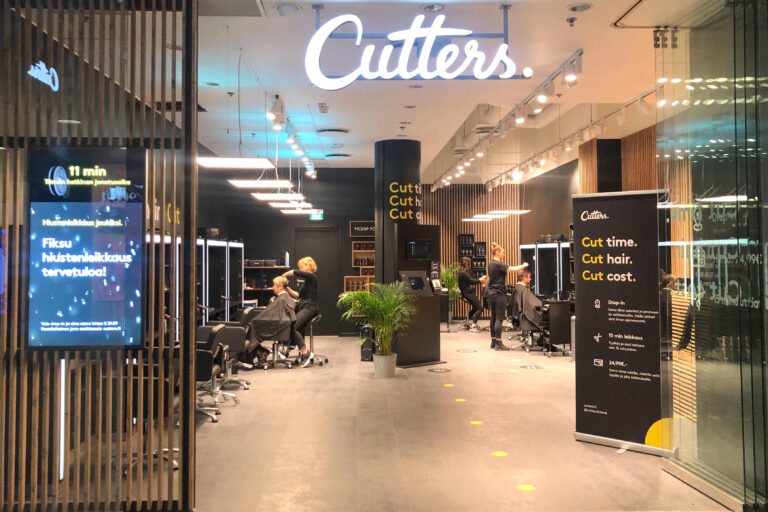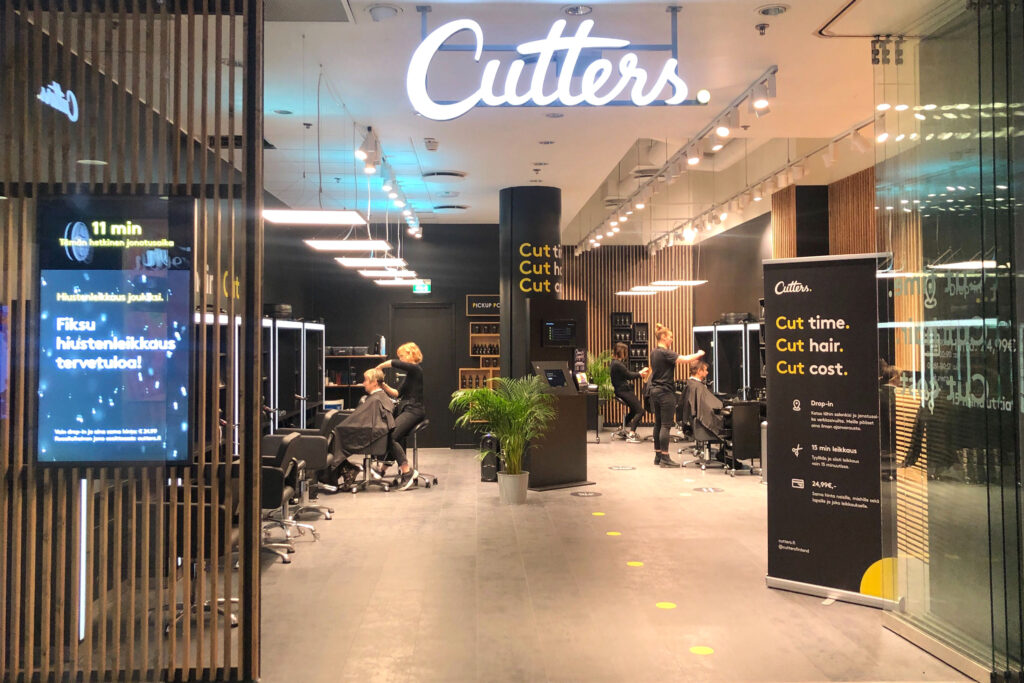
Familiar music is an important mood maker – for both the customers and employees of this salon franchise

They quickly found out that the musical diversity and playlist scope was not up to the expectations set by their brand and customer experience. The problem was solved by expanding the service to include well-known music.
Cutters is a new type of barber and hairdresser franchise that operates 12 salons in six different localities in Finland. The roots of the company are in Norway, where the first Cutters salon was established in 2015.
The Cutters concept is based on speed, quality, and allowing the hairdressers to focus on what matters: the customer’s hair. The salons are available without booking, offering fixed-price 15-minute slots and a real-time online display of waiting times. Payments are made digitally. The system is designed to be as easy and smooth as possible for both the customer and the hairdresser.
– Music is an important element in building the overall atmosphere in a salon, says Karri Niinivaara, who is responsible for Cutters marketing in Finland.
– If music stops for example because of a technical issue, the mood is immediately flattened. Even though a customer visit only takes 15 minutes, that is enough to hear music, making it important to not repeat the same songs.
Music selection at the franchise level takes thought
How is music chosen for such a big franchise with salons in different regions and in different kinds of environments? Cutters found their policy by trial and error.
– Early on, some salons played the radio while some played other types of music. However, this was a bit messy and created a sense of not having a clear style, so the franchise brought on board a musical partner who created unified playlists for the salons.
Library music generated negative feedback
Of the playlist service provided by the musical partner, unknown music services or so-called library music playlists were first put to use, meaning playing music that was licensed into the playlist service but was not played for instance on the radio.
– We felt that this was an opportunity to save on music, because we did not have to pay royalties. We also thought that by playing music by unknown artists and musicians, we could support them and provide opportunities for them.
However, it soon became apparent that library music does not meet the needs of barber salons. Feedback was received from customers, but especially from employees.
– The playlists were quite short. The same songs would repeat, and when the employees provided feedback on this, the playlist service could not act upon it, says Karri Niinivaara.
– We had decided at a conceptual level that our main genre would be tropical electronic hip hop, but the music on the playlists was mainly repetitious disco, he laughs.
– We had planned that the music would be more calm when the salons open and then pick up in tempo and intensity towards the more busy afternoon hours. However, due to the shortness of the playlists, the music was quite similar throughout the day. The worst thing was that the same songs were being repeated.
The feedback from the staff and customers caused the franchise to get involved and the musical partner service was expanded to include playlists consisting of songs performed by known artists. At the same time, music licenses were acquired for all 12 salons in order to make sure that the makers and performers of music would get the compensation they deserve. This also guarantees the viability of making music professionally in the future as well.
“Radio Cutters” plays music that the customers know
Going from library music to known music was possible without changing the service provider. Changing the music selection and expanding the playlists was immediately felt, especially in the feedback from employees.
– Our musical partner was able to provide a service that included taking known copyrighted music and using it to create ready-made playlists sorted by genre and mood. This service was adopted in all salons both in Finland as well as in Norway, Niinivaara says.
– Since the change, the feedback on the music has been exclusively positive. At first, the employees were amazed that they could play this kind of music and wondered where it’s coming from, it was so good.
– The best thing is that there are all kinds of playlists, from “hits only” to r’n’b focused and even Christmas music. All playlists are in line with the Cutters brand, meaning that the music is always just right regardless of the genre, style, or age.
In the near future, audio branding can also be done by means of channel tags and sound advertising.
– The service makes it possible to also play “Radio Cutters” style brand jingles and product ads in our salons. This introduces a whole new layer to the audio atmosphere of the salons.
Investing in music means investing in the brand, employee well-being, and the customer experience
Music should be seen as an investment that affects employee satisfaction in particular and thus the success of the business, Karri Niinivaara says.
– A package where we pay for both a music service and licenses is not the cheapest way of playing music. On the other hand, as there are fewer customers due to the Coronavirus, music is a big deal especially in terms of employee well-being. And, when the customers hopefully start coming back once the exceptional circumstances are gone, music will play a large role in the generation of the customer experience and the memories we make.
What would Cutters have to say to businesses and franchises that are thinking about the role and use of music?
– In addition to customer feedback, it is very important to hear those who listen to the background music every day while working. I can say whatever I want about the music from my office, but our employees are there every day listening to and experiencing the audio atmosphere. It is obvious that they have the best understanding of what kind of music works and what does not.

Karri Niinivaara is responsible for the marketing of Cutters in Finland



